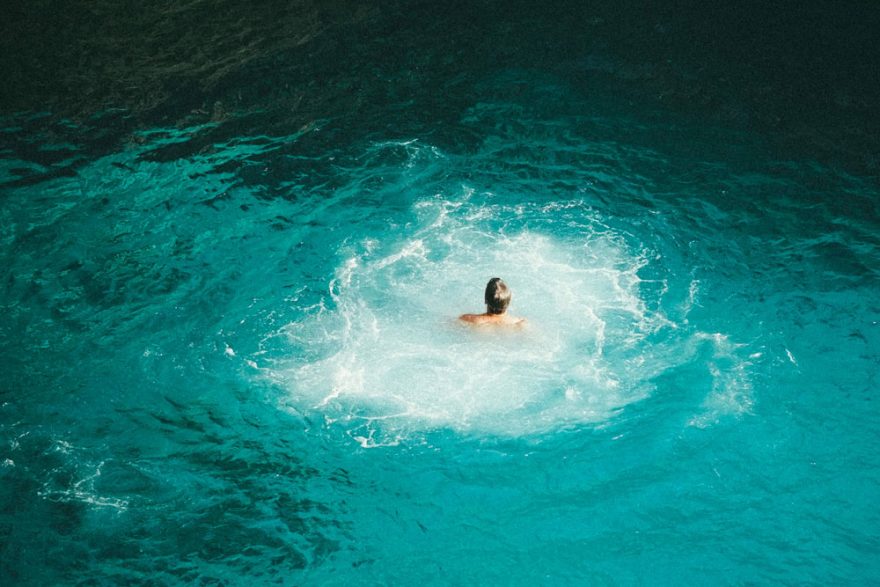
Have you ever watched a great swimmer and been amazed at how effortless they make it look? It seems that with every stroke, they simply glide through the water. What can be equally frustrating as amazing is how they appear to not be tired at all afterwards.
The truth is, unless you are involved in the sport at a competitive level, you probably know very little about the correct technique of swimming. Swimming is a very technical sport and it’s something that us humans are very naturally inefficient at, unlike running.
The Open Water
You may consider yourself a relatively good pool swimmer, but if you’ve ever tried swimming in the open water, then you’ll know it’s a completely different game.
Firstly, the water temperature is considerably different and it can be hard to adjust to the difference if you are swimming in cold water. Your muscles tire much more quickly in cold water vs. warm water.
Next, you have to account for the waves and any currents you might have to swim through or against.
We’re diving into some of the key technique points you can action right away to improve your open water swimming. Of course, some of these will be great for pool swimming as well.
Arms

The ideal in swimming is to be able to swim further and faster with equal or less energy expended. In other words, you should always be aiming to make your stroke more efficient in every aspect.
Stroke Length
The first aspect we’re going to look at is your arm reach. Many swimmers at a beginner or intermediate level tend not to get much propulsion from each arm pull.
One of the main reasons for this is that they land their hand in the water right next to their head, instead of really stretching out and forward. If you stretch for your hand to enter further in front of you, you’ll manage to grab and pull more water with each stroke.
The next part of the stroke length you can work on is the exit, rather than entry. So, that’s the part your hand leaves the water again before coming over the water. You should try to make sure your arm pulls right the way past your hip, before coming out the water.
Finally, as your hand is coming back into the water, aim to rotate your body ever so slightly. If your right hand is entering, start to roll your body onto your right side. This will allow you to reach further.
Smooth Entry
Another common mistake made is that people tend to splash their hand as it enters the water. By doing this, you create bubbles. Bubbles, of course, are pockets of air.
Therefore, the more air you are making, the less water you will be pulling which makes each arm pull less efficient. Try to place your hand in with each stroke and think about gliding it through the water. Imagine your hand as an airplane landing.
Legs
Your legs should be though of as your engine. If you’re driving your car and you switch the engine off, what will happen? You’ll slow down and stop.
Kicking Speed
In swimming, most of the power in your stroke comes from your legs, so it is important to maintain a strong and steady leg kick throughout your swim. Ideally, you should swim with a 6 beat kick, which means that for every two arm pulls, you complete 6 kicks.
However, longer distance swims require you to conserve more energy, therefore you can afford to have a more relaxed leg kick.
Power from the Kick
In order to get the most power from each kick, you should always aim for the driving force to come from your hips and upper leg portion, rather than a big bend at the knees.
Those who cycle their legs will quickly burn out. Firstly, it isn’t streamlined to have your legs in that position. Secondly, the bottom portion of your leg will never generate nearly as much power as your quads and hips.
Head Position & Breathing

Without you realizing, the position your head is in dictates what the rest of your body does. If you lie flat on your back in the water and you lift your head up out the water, your legs will sink.
Applying that knowledge when your swimming can put you in a much better position. If you keep your eyes down (rather than looking forward), your body will lie much flatter in the water.
Sighting
With open water swimming, there aren’t any markers for you to know which direction you’re swimming. This is where you need to find your own rhythm.
Try to find objects in front of you which don’t move (buildings/buoys) and lift your head every few strokes as you breathe in order to spot them. You should make sure that this process becomes a natural part of the stroke and doesn’t interrupt your momentum.
Breath Control
One of the main complaints or sticking points for swimmers is the feeling of being out of breath much quicker than they become physically tired. This almost always comes down to controlling breathing under the water.
You should never attempt to hold your breath while swimming. If you were to hold your breath when your face is in the water, you then have to exhale every time you turn to breathe, thus never really getting a good breath in.
Instead, always gently exhale when your face is in the water. That way, when it comes to breathing, you’ll get a nice full breath in naturally. This will allow you to swim much further, without that feeling of always running out of air.
Additionally, you should aim to breathe in patterns; either every 2, 3 or 4 strokes. Just as long as you’re keeping to a pattern to help with your timing.
 Your Privacy Choices
Your Privacy Choices
 The
The